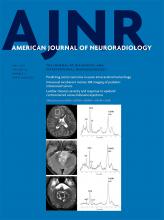Abstract
BACKGROUND AND PURPOSE: Atypical teratoid/rhabdoid tumors are rare, aggressive central nervous system tumors that are predominantly encountered in very young children. Our aim was to determine whether in vivo metabolic profiles correlate with molecular features of central nervous system pediatric atypical teratoid/rhabdoid tumors.
MATERIALS AND METHODS: Twenty confirmed patients with atypical teratoid/rhabdoid tumors who underwent MR spectroscopy were included in this study. In vivo metabolite levels of atypical teratoid/rhabdoid tumors were compared with molecular subtypes assessed by achaete-scute homolog 1 expression. Additionally, brain-specific creatine kinase levels were determined in tissue samples.
RESULTS: In vivo creatine concentrations were higher in tumors that demonstrated achaete-scute homolog 1 expression compared with those without achaete-scute homolog 1 expression (3.42 ± 1.1 versus 1.8 ± 0.8 IU, P < .01). Additionally, levels of myo-inositol (mI) (9.0 ± 1.5 versus 4.7 ± 3.6 IU, P < .05) were significantly different, whereas lipids approached significance (44 ± 20 versus 80 ± 30 IU, P = .07) in these 2 cohorts. Higher brain-specific creatine kinase levels were observed in the cohort with achaete-scute homolog 1 expression (P < .05). Pearson correlation analysis showed a significant positive correlation of brain-specific creatine kinase with absolute creatine (P < .05) and myo-inositol (P < .05) concentrations.
CONCLUSIONS: In vivo MR spectroscopy may predict key molecular features of atypical teratoid/rhabdoid tumors at initial diagnosis, leading to timely patient risk stratification and accelerating the development of targeted therapies.
ABBREVIATIONS:
- ASCL1
- achaete-scute homolog 1
- AT/RT
- atypical teratoid/rhabdoid tumor
- CKB
- brain-specific creatine kinase
- Cr
- creatine
- mI
- myo-inositol
- Cho
- choline
- SMARCB1
- SWI/SNF-related matrix-associated actin-dependent regulator of chromatin subfamily B member 1
- © 2019 by American Journal of Neuroradiology












